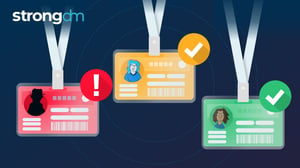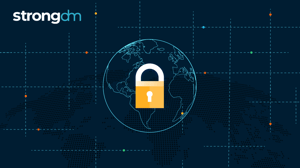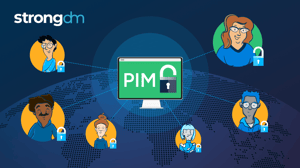
- Role-based, attribute-based, & just-in-time access to infrastructure
- Connect any person or service to any infrastructure, anywhere
- Logging like you've never seen

My first car was a ’77 Pontiac Grand Prix. It guzzled gas, smelled like an old shoe, had ripped seats, and only played AM radio. And man, I wish I still had it.
Sure, it was impractical—maintenance was a nightmare, and parking it felt like docking an aircraft carrier. But nostalgia makes me long for it anyway. The thing is, it wouldn’t even fit in my garage.
For companies still clinging to legacy Privileged Access Management (PAM) tools, there’s no nostalgia—just frustration. No fond memories of endless patching, no love for rigid access models that don’t scale. Just inefficiency and mounting costs.
Yet, many persist, gripping those outdated tools like a rusty old car that barely sputters to life. The difference? At least my Pontiac had charm.
Old cars are cool, but they’re not essential. Software doesn’t need to be cool, but it is necessary. And in a world where access is everything, holding onto legacy PAM isn’t just inefficient—it’s actively costing you. Time. Money. Security.
You deserve a modern, high-performance solution.
The Hidden Costs of Legacy PAM
At first glance, legacy PAM tools might seem like a safe bet. They’re familiar and established, and they’ve been getting you from here to there for years. But take a look under the hood, and you’ll see that they’re quietly draining your resources. Here’s how:
Operational Drag
Legacy PAM solutions struggle with today’s complex IT environments, requiring manual processes, clunky interfaces, and constant configuration. Managing access becomes time-consuming, burdening IT teams and increasing inefficiencies. Additionally, younger workers are not being trained to handle these outdated tools, making long-term management even more challenging.
Legacy PAM solutions were not built for the complexity of today’s environments. Enterprises now operate across hybrid clouds, multi-cloud deployments, and sprawling on-prem environments.
Managing access across these distributed systems with legacy tools involves manual processes, clunky interfaces, and constant configuration tweaks. IT and security teams find themselves bogged down in the minutiae of managing and updating policies, tracking sessions, and ensuring compliance. What should take minutes stretches into hours—and those hours pile up. Additionally, the pool of younger workers who will be critical to your IT team is no longer being trained on the skills required to manage these types of tools.
Summary of the operational hidden costs:
- Manual processes slow IT/security teams.
- Clunky interfaces require constant tweaks.
- Tracking sessions and policies is time-consuming.
- Compliance reporting is labor-intensive.
- Hiring/training for legacy systems is difficult.
Shadow IT and Access Workarounds
When legacy PAM tools slow access, developers create workarounds (shadow IT) to bypass security policies, leading to unmanaged and risky access. Over time, these shortcuts multiply, increasing security vulnerabilities and making the entire environment more exposed to threats.
When PAM tools become a bottleneck, developers create workarounds – otherwise known as shadow IT – where users bypass official access policies to avoid the delays that come with adherence to PAM security dictates.
Not only does this undermine security, but it also creates an opaque environment where sensitive systems are accessed without oversight. In the long run, these workarounds introduce significant risk—all because the existing PAM infrastructure is too cumbersome. And consider that the longer the legacy solution is around, the more workarounds and “cheat codes” get applied. That creates a mathematical problem that exponentiates the risk of the entire environment.
Summary of the shadow IT and access workaround hidden costs:
- Users bypass security due to PAM delays.
- Unauthorized access increases risk.
- Lack of visibility complicates compliance.
- Workarounds multiply, escalating security threats.
- Sensitive data becomes more exposed.
The Maintenance Quagmire
Maintaining legacy PAM tools requires constant patching and troubleshooting, diverting resources from strategic security initiatives. Delayed updates create vulnerabilities, increasing security risks and potential compliance fines. Instead of improving security, teams are stuck keeping outdated systems running.
Keeping legacy PAM tools afloat requires ongoing maintenance, patching, and troubleshooting. I’m not ashamed to admit that duct tape and bottle after bottle of Stop Leak kept my old Pontiac running way longer than it should have, but that approach to your IT environment will result in massive fines and expose your company to tremendous risk.
If tools aren’t properly updated (or if updates are delayed due to compatibility issues), vulnerabilities will inevitably creep in. The maintenance burden also means less time for strategic initiatives—like improving overall security posture or implementing Zero Trust frameworks.
Summary of the maintenance hidden costs:
- Patching and troubleshooting drain resources.
- Delayed updates create security gaps.
- Compatibility issues disrupt operations.
- Maintenance costs rise as value declines.
- Teams focus on fixes, not strategy.
License Juggling and Scaling Costs
Legacy PAM licensing models don’t scale easily, leading to high costs and administrative overhead. Security teams must constantly juggle licenses to balance access and budget, creating inefficiencies, added expenses, and increased risk of mismanagement.
Traditional PAM licensing models aren’t designed for dynamic scaling. Need to onboard a new team or expand access controls to a growing infrastructure? Be prepared for additional licensing costs and administrative overhead, and it never ends.
Security and compliance teams find themselves stuck in a constant balancing act—juggling licenses to avoid overspending while ensuring users have the access they need. It’s inefficient, expensive, and prone to mismanagement.
Summary of the license and scaling hidden costs:
- Rigid licensing leads to high costs.
- Expanding access requires expensive add-ons.
- Balancing access needs strains budgets.
- Overspending or under-provisioning causes inefficiencies.
- Admin overhead grows with licensing management.
The Security Gaps That Legacy PAM Leaves Open
The financial and operational costs are only half the story. Legacy PAM systems introduce critical security gaps that directly increase your attack surface.
Incomplete Session Monitoring
Legacy tools lack the granularity to monitor and control every privileged session across modern environments. In a world of ephemeral cloud instances and microservices, PAM solutions need to adapt in real-time. Without full visibility, attackers can exploit gaps, lingering in systems undetected.
Static Access Models
Traditional PAM operates on static access models, where users are granted standing privileges for extended periods. This contradicts the principles of Zero Trust, which emphasize least privilege and just-in-time (JIT) access. The result? Users have access to sensitive systems far longer than necessary, increasing the window of opportunity for insider threats or credential compromise.
Disjointed Environments
Enterprises today operate in fragmented environments. Legacy PAM tools struggle to unify access policies across different platforms, creating inconsistencies that attackers can exploit. Without seamless integration across cloud, on-prem, and DevOps pipelines, security gaps inevitably form.
The Weight of PAM Technical Debt
Let’s get down to the reality of what clinging to a legacy PAM is costing you in terms of the financial and resource debt you incur as you continue to keep these types of tools alive. These are the accumulated inefficiencies, security risks, and operational bottlenecks that arise from using outdated or overly complex PAM tools. Over time, they compound, and they hurt your bottom line in a variety of ways.
Siloed Tools
Legacy PAM tools typically operate in isolation, making centralized governance or interoperability nearly impossible. This fragmented approach leaves security blind spots and increases the likelihood of unauthorized access. CyberArk, for example, is notorious for its limited integrations, which exacerbate these silos. Honestly, ask anyone who is using CyberArk, and they will tell you stories about pulling their hair out while trying just to “make it work.”
⚠️ Traditional PAM deployments have gaps. Learn how to protect your databases, the cloud, Kubernetes, and more with our legacy PAM augmentation guide.
Legacy Infrastructure
Old PAM solutions were built for on-premises environments and struggle to adapt to hybrid or multi-cloud architectures. As enterprises migrate to cloud-based environments, these tools lag behind, causing poor scalability and cumbersome deployments.
Incomplete Discovery
Legacy PAM systems often lack continuous discovery capabilities. This results in unmanaged machine identities, orphaned accounts, and ephemeral resources flying under the radar. Attackers exploit these gaps to gain footholds within an organization.
Poor IAM Hygiene
Here’s what users of legacy PAM solutions experience: Manual processes, inconsistent enforcement of least privilege, and limited analytics, all of which lead to security hygiene issues. Over-provisioned privileges (like RBAC) and dormant accounts increase the attack surface, exposing enterprises to insider threats and compliance failures.
User Frustration and Adoption Issues
Outdated PAM interfaces are complex and require extensive training for those who manage them. CyberArk’s user experience, for instance, frequently deters user adoption, forcing teams to resort to workarounds or neglect critical access controls altogether. Also, bear in mind that the younger workforce is not being trained in the skills required to operate overly complex tools like these.
Operational Inefficiency
High maintenance costs, resource-intensive deployments, and constant troubleshooting drain IT budgets. Security teams end up spending more time fixing legacy PAM than working on strategic initiatives.
Inability to Scale
Modern enterprises demand agile, cloud-native, and scalable solutions. Legacy PAM systems can’t keep up with DevOps workflows or ephemeral cloud environments, limiting growth and innovation.
Missed Insights and Analytics
Limited visibility into access patterns and session protocol-awareness hinders proactive threat detection. Without robust analytics and real-time monitoring, identifying anomalies and enforcing policies becomes a reactive process.
By addressing PAM technical debt, enterprises can reduce operational friction, lower costs, and create a more resilient security posture aligned with Zero Trust principles.
From PAM Debt to Zero Trust: A Necessary Shift
The shift to Zero Trust access isn't just a trend—it's a strategic necessity for modern enterprises. StrongDM's Secure Access Maturity Model (SAMM) provides a roadmap for organizations to evolve their access management practices and fully realize the potential of Zero Trust PAM solutions, addressing the core issues that legacy tools perpetuate:
- Dynamic, Adaptive Access: A Zero Trust approach emphasizes the importance of provisioning access dynamically, based on user context, risk levels, and session parameters. StrongDM enables this by providing a centralized system that evaluates and enforces access policies in real-time, ensuring security adapts as your environment does.
- Just-in-Time Privileges: Legacy tools often rely on static entitlements, which can lead to overprovisioning and added security risks. In contrast, a move to just-in-time access helps address these risks. With StrongDM, users get precisely what they need—when they need it—and only for as long as necessary, minimizing exposure.
- Seamless Integration: One of the foundational tenets of Zero Trust PAM is that secure access must integrate across all layers of modern IT—cloud, DevOps, and traditional systems. StrongDM exemplifies this by unifying access control and eliminating silos, reducing operational friction while strengthening security.
By following the principles of Zero Trust PAM and shedding the weight of legacy PAM solutions, enterprises can transition from reactive to proactive, comprehensive access management. This not only eliminates operational drag but also reduces costs and significantly enhances their security posture, paving the way for sustainable growth in an increasingly dynamic IT landscape.
How StrongDM Has Changed Privileged Access
If legacy PAM is the clunker on cinder blocks on your front lawn, StrongDM is the high-performance vehicle designed for the modern era. It’s not just an upgrade; it’s a complete reimagining of what privileged access management should be, and it’s been done by people who think deeply about what it takes to make access actually prevent breaches and protect your infrastructures.
We operate according to these core design principles:
- Trust must be assessed continuously.
- Security must be applied universally.
- No one should have access unless it's actually being used.
- Credentials that can be seen are assumed to be breached.
- Complete visibility is an absolute necessity.
Instead of patching together disparate tools or juggling endless licenses, StrongDM provides a unified platform that aligns with the speed and complexity of today’s hybrid environments. It cuts through the inefficiencies and risk that plague legacy systems, offering a seamless, intuitive experience that scales as your infrastructure evolves.
Here’s how we’re redefining PAM by eliminating many of the pain points associated with legacy solutions:
Simplified Deployment and Management: StrongDM requires no resource agents or legacy prerequisites, enabling frictionless onboarding. Deployment is fast; teams can see value in days, not months.
Broad Resource Coverage: StrongDM supports modern and legacy systems out of the box, including Kubernetes, cloud-native services, cloud management consoles, network devices, and SaaS applications. This ensures comprehensive coverage across diverse environments.
Integrates with All Vaults: Unlike other PAM solutions, StrongDM is vault-agnostic and integrates with all legacy (and modern) vaults and key stores, so organizations are free to use their vault(s) of choice. This enables organizations to keep their secrets where they already live but manage them from a centralized location.
User-Friendly Experience: With intuitive interfaces and integrations with ChatOps tools like Slack, Jira, ServiceNow, and Microsoft Teams, StrongDM improves user adoption and minimizes training requirements. Developers can continue using the development tools they are familiar with and don’t have to change the workflows. Security teams can focus on strategic initiatives rather than troubleshooting access issues.
Zero Trust Readiness: StrongDM enforces Just-in-Time (JIT) access and dynamic policy controls, seamlessly integrating device trust signals and continuous authorization to align with Zero Trust principles.
Cost Efficiency: By centralizing governance and decentralizing enforcement, StrongDM reduces operational overhead. It scales with your infrastructure without introducing complexity or licensing headaches.
Fine-Grained Authorization: StrongDM enables precise access controls through granular policies, supporting Zero Standing Privileges (ZSP) and dynamic, contextual access decisions. Access adapts in real time based on user roles, device trust, and session conditions.
Nostalgia is Great for Memories, Not for PAMs
Closing your eyes, you can almost hear the sputter of that old Pontiac as you turn the key. But in today’s enterprise, you can’t afford to keep coaxing a relic along, hoping it will get you where you need to go. It’s time to trade in the past and drive forward with something designed to meet the needs of modern roads—because your business deserves more than just barely making it to the finish line.
About the Author
Tim Prendergast, Chief Executive Officer (CEO), before joining StrongDM, Tim founded Evident.io—the first real-time API-based cloud security platform. In 2018, Palo Alto Networks (PANW) acquired Evident.io, and Tim joined the executive team at PANW. As the first Chief Cloud Officer, Tim helped outline GTM and product strategy with the C-suite for the cloud business. Tim also served as the principal architect for Adobe's Cloud Team, designing and scaling elastic AWS infrastructure to spark digital transformation across the industry. Tim’s love for innovation drives his interest as an investor in true market disrupters. He enjoys mentoring startup founders and serving as an advisor.

You May Also Like





